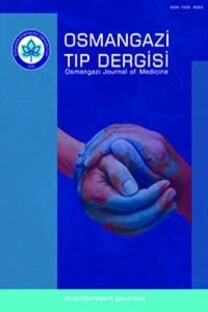Çocuklarda Ayna Hayali Hareketler; Tek Merkez Deneyimi
Çocuk, ayna hayali hareketler
Mirror Movement in Children; A Single Center Experience
children, mirror movement,
___
- 1. Cincotta M, Lori S, Gangemi PF, Barontini F, et al. Hand Motor Cortex Activation in a Patient with Congenital Mirror Movements: a Study of the Silent Period Following Focal Transcranial Magnetic Stimulation. Electroencephalogr Clin Neurophysiol 1996;101(3):240-6.
- 2. Verstynen T, Spencer R, Stinear CM, Konkle T, et al. Ipsilateral Corticospinal Projections do not Predict Congenital Mirror Movements: a Case Report. Neuropsychologia. 2007;45(4):844-52
- 3. Adler C, Berweck S, Lidzba K, Becher T, et al. Mirror Movements in Unilateral Spastic Cerebral Palsy: Specific Negative Impact on Bimanual Activities of Daily Living. Eur J Paediatr Neurol. 2015;19(5):504-9.
- 4. Cincotta M, Ziemann U. Neurophysiology of Unimanual Motor Control and Mirror Movements. Clin Neurophysiol. 2008;119(4):744-62
- 5. Cincotta M, Borgheresi A, Balestrieri F, Giovannelli F, et al. Involvement of the Human Dorsal Premotor Cortex in Unimanual Motor Control: an Interference Approach Using Transcranial Magnetic Stimulation. Neuroscience Letters. 2004;367(2):189-93
- 6. Gazzaniga MS. Cerebral Specialization and Interhemispheric Communication. Does the Corpus Callosum Enable the Human Condition?. Brain. 2000;123(7):1293-326.
- 7. Müller K, Kass-Iliyya F, Reitz M. Ontogeny of Ipsilateral Corticospinal Projections: A Developmental Study with Transcranial Magnetic Stimulation. Ann Neurol. 1997;42(5):705-11.
- 8. Rasmussen P. Persistent Mirror Movements: A Clinical Study of 17 Children, Adolescents and Young Adults. Dev Med Child Neurol. 1993;35(8):699-707
- 9. Rizzolatti G, Luppino G. The Cortical Motor System. Neuron. 2001;31(6):889-901
- 10. Cincotta M, Borgheresi A, Boffi P, Vigliano P, et al. Bilateral Motor Cortex Output with Intended Unimanual Contraction in Congenital Mirror Movements. Neurology. 2002;58(8):1290-3.
- 11. Galléa C, Popa T, Billot S, Méneret A, et al. Congenital Mirror Movements: A Clue to Understanding Bimanual Motor Control. J Neurol. 2011;258(11):1911-9
- 12. Chen LC, Liu MY, Hsiao YC, Choong WK, et al. Decoding the Disease-associated Proteins Encoded in the Human Chromosome 4. J Proteome Res. 2013;12(1):33-44.
- 13. Depienne C, Cincotta M, Billot S, Bouteiller D, et al. A Novel DCC Mutation and Genetic Heterogeneity in Congenital Mirror Movements. Neurology. 2011;76(3):260-4.
- 14. Erol FS, Topsakal C, Ozveren MF, Akdemir I, et al. Meningocele with Cervical Dermoid Sinus Tract Presenting with Congenital Mirror Movement and Recurrent Meningitis. Yonsei Med J. 2004;45(3):568-72
- 15. Mahirogullari M, Ozkan H, Yildirim N, Cilli F, et al. Klippel-Feil Syndrome and Associated Congenital Abnormalities: Evaluation of 23 Cases. Acta Orthop Traumatol Turc. 2006;40(3):234-9.
- 16. Reitz M, Müller K. Differences Between Congenital Mirror Movements and Associated Movements in Normal Children: A Neurophysiological Case Study. Neurosci Lett. 1998;256(2):69-72
- 17. Gunderson CH, Solitare GB. Mirror Movements in Patients with the Klippel-Feil Syndrome. Neuropathologic Observations. Arch Neurol. 1968;18(6):675-9.
- 18. Schott GD, Wyke MA. Congenital Mirror Movements. J Neurol Neurosurg Psychiatr. 1981;44(7):586-99
- 19. Nadkarni NA, Deshmukh SS. Mirror Movements. Ann Indian Acad Neurol. 2012;15(1):13-4
- 20. Orth M, Münchau A. Transcranial Magnetic Stimulation Studies of Sensorimotor Networks in Tourette Syndrome. Behav Neurol. 2013;27(1):57-64
- ISSN: 1305-4953
- Yayın Aralığı: 6
- Başlangıç: 2013
- Yayıncı: Eskişehir Osmangazi Üniversitesi Rektörlüğü
Sigara Alışkanlığının İmplant Üstü Sabit Protezler Üzerine Etkileri: Retrospektif Çalışma
Fare Isırığı Sonrası Gelişen Corynebacterium spp’ye Bağlı Selülit ve Septik Artrit
Berke ARAS, Dilara YILDIRIM, Mustafa YILMAZ
Olgu sunumu: Tek İnsizyonla İkinci Brankial Yarık Fistülün Çıkarılması
Çocuklarda Ayna Hayali Hareketler; Tek Merkez Deneyimi
Ozan KOCAK, Kürşat Bora CARMAN, Çoşkun YARAR
Melanositik Nevuslarda Klinik, Dermoskopik ve Histopatolojik Korelasyon
Asude KARA POLAT, İlham SABUNCU, Evrim YILMAZ, Zeynep SARAÇOĞLU NURHAN, Ayşe Esra KOKU AKSU, Muzaffer BİLGİN
Tek İnsizyonla İkinci Brankial Yarık Fistülün Çıkarılması
Fare ısırığı Sonrası Gelişen Corynebacterium spp’ye Bağlı Selülit ve Septik Artrit
